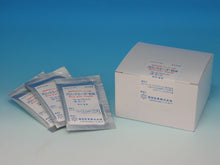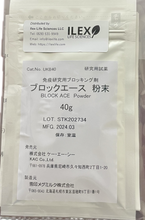Description
Block Ace is a blocking agent prepared from bovine milk proteins (lactoprotein). Since lactoprotein contains a lot of hydrophobic groups, it shows a high affinity to plastic, membrane filter, etc. Block Ace exhibits a superior blocking effect on nonspecific adsorption of antigens or antibodies in the ELISA, RIA and immunoblocking methods compared with conventional blocking agents such as BSA (Bovine Serum Albumin).
Features
Since this product has high blocking effects and maintains the background at a low level, it is useful for low-concentration measurement such as ELISA.
- Heat-treated and thus bovine-derived antibodies, enzymes and viruses are inactivated.
- It is stable for heat and freezing.
- It can stabilize physiologically active substances and can be used as a diluting agent.
- Compared with BSA solution, it is economical.
- It can be rapidly dissolved in water.
Comparison to BSA
Comparison of blocking effects between Block Ace and 1% BSA solution.

Anti-human kappa-chain antibodies and anti-human lambda-chain antibodies are coated, and it is blocked with either Block Ace or 1% BSA. Human IgG ELISA demonstrates that Block Ace has low background and a steep standard curve (Hiroshi, S. et al., Report of Snow Brand Milk Products Co., Ltd, Research Laboratory).
Reconstitution
Four (4) grams of Block Ace powder is dissolved into 100 mL of purified water, and this solution is used as a concentrate.
Application Recommendations
- ELISA Blocking: A blocking solution for ELISA is prepared by diluting the reconstituted solution 4-fold with distilled water.
- Western Blot Blocking: For a blocking solution for Western Blot, use undiluted reconstituted solution.
- ELISA Washing Solution: For washing operation in the B/F separation, etc., dilute the reconstituted solution 10-fold with distilled water and add Tween20 to make a final concentration of 0.05 - 0.2%.
- Diluent: For dilution of test sample and second conjugated antibody, dilute the reconstituted solution 10-fold with distilled water.
Storage
Prior to reconstitution store at +4℃. This product is heat treated, but there is no preservative or antibiotic. Once dissolved, it should be frozen before storage.
Manufacturer
KAC Co., Ltd., Kyoto-city 603-8432, Japan
Usage
This product is intended for Laboratory Research Use Only. Not for use in diagnostic or therapeutic procedures. This product may not be used as a pharmaceutical or veterinary drug, agricultural product, or food additive.
Documents
Product References
- Kim, Mee-Hae et al. “An in vitro culture platform for studying the effect of collective cell migration on spatial self-organization within induced pluripotent stem cell colonies.” Journal of biological engineering vol. 17,1 25. 30 Mar. 2023, doi:10.1186/s13036-023-00341-z
- Yang, Lili et al. “Fluorouracil exacerbates alpha-crystallin B chain-mediated cell migration in triple-negative breast cancer cell lines.” Scientific reports vol. 13,1 4010. 10 Mar. 2023, doi:10.1038/s41598-023-31186-7
- Sugiyama, Shintaro et al. “The tight junction protein occludin modulates blood-brain barrier integrity and neurological function after ischemic stroke in mice.” Scientific reports vol. 13,1 2892. 18 Feb. 2023, doi:10.1038/s41598-023-29894-1
- Sayama, Yusuke et al. “Seroprevalence of four endemic human coronaviruses and, reactivity and neutralization capability against SARS-CoV-2 among children in the Philippines.” Scientific reports vol. 13,1 2310. 9 Feb. 2023, doi:10.1038/s41598-023-29072-3
- Hashimoto, Yu et al. “Connexin 30 Deficiency Ameliorates Disease Progression at the Early Phase in a Mouse Model of Amyotrophic Lateral Sclerosis by Suppressing Glial Inflammation.” International journal of molecular sciences vol. 23,24 16046. 16 Dec. 2022, doi:10.3390/ijms232416046
- Hirayama, Teruyoshi et al. “CTCF loss induces giant lamellar bodies in Purkinje cell dendrites.” Acta neuropathologica communications vol. 10,1 172. 29 Nov. 2022, doi:10.1186/s40478-022-01478-6
- Sasaki, Michihito et al. “S-217622, a SARS-CoV-2 main protease inhibitor, decreases viral load and ameliorates COVID-19 severity in hamsters.” Science translational medicine vol. 15,679 (2023): eabq4064. doi:10.1126/scitranslmed.abq4064
- Takeishi, Makoto et al. “Seroconversion of anti-Getah virus antibody among Japanese native Noma horses around 2012.” The Journal of veterinary medical science vol. 84,12 (2022): 1605-1609. doi:10.1292/jvms.22-0306
- Ogawa, Eiji et al. “Naïve pluripotent-like characteristics of non-tumorigenic Muse cells isolated from human amniotic membrane.” Scientific reports vol. 12,1 17222. 14 Oct. 2022, doi:10.1038/s41598-022-22282-1
- Matsuda, Teppei et al. “Efficient antigen delivery by dendritic cell-targeting peptide via nucleolin confers superior vaccine effects in mice.” iScience vol. 25,11 105324. 10 Oct. 2022, doi:10.1016/j.isci.2022.105324
- Kitagawa, Satoki et al. “Elucidation of the role of nucleolin as a cell surface receptor for nucleic acid-based adjuvants.” NPJ vaccines vol. 7,1 115. 6 Oct. 2022, doi:10.1038/s41541-022-00541-6
- Hong, Jing et al. “Leishmania infection-induced multinucleated giant cell formation via upregulation of ATP6V0D2 expression.” Frontiers in cellular and infection microbiology vol. 12 953785. 23 Sep. 2022, doi:10.3389/fcimb.2022.953785
- Hatayama, Minoru et al. “SLITRK1-mediated noradrenergic projection suppression in the neonatal prefrontal cortex.” Communications biology vol. 5,1 935. 9 Sep. 2022, doi:10.1038/s42003-022-03891-y
- Shimada, Hiroko et al. “A next-generation iPSC-derived forebrain organoid model of tauopathy with tau fibrils by AAV-mediated gene transfer.” Cell reports methods vol. 2,9 100289. 8 Sep. 2022, doi:10.1016/j.crmeth.2022.100289
- Ishijima, Keita et al. “Lethal Disease in Dogs Naturally Infected with Severe Fever with Thrombocytopenia Syndrome Virus.” Viruses vol. 14,9 1963. 4 Sep. 2022, doi:10.3390/v14091963
- Matsuo, Taisuke et al. “Olanzapine enhances adipogenesis and suppresses lipolysis in 3T3‑L1 adipocytes under low‑glucose and weak differentiation/maturation conditions.” Experimental and therapeutic medicine vol. 24,5 647. 1 Sep. 2022, doi:10.3892/etm.2022.11584
- Shirai, Takanobu et al. “Basal extrusion of single-oncogenic mutant cells induces dome-like structures with altered microenvironments.” Cancer science vol. 113,11 (2022): 3710-3721. doi:10.1111/cas.15483
- Nakadate, Kazuhiko, and Kiyoharu Kawakami. “Distribution and Localization of Mahogunin Ring Finger 1 in the Mouse Central Nervous System.” International journal of molecular sciences vol. 23,16 8956. 11 Aug. 2022, doi:10.3390/ijms23168956
- Yamada, Yukinori et al. “Hypoallergenic Wheat Line (1BS-18H) Lacking ω5-Gliadin Induces Oral Tolerance to Wheat Gluten Proteins in a Rat Model of Wheat Allergy.” Foods (Basel, Switzerland) vol. 11,15 2181. 22 Jul. 2022, doi:10.3390/foods11152181
- And many more on PubMed Central.
Related Products
Ilex Life Sciences LLC is an authorized distributor of Block Ace.




